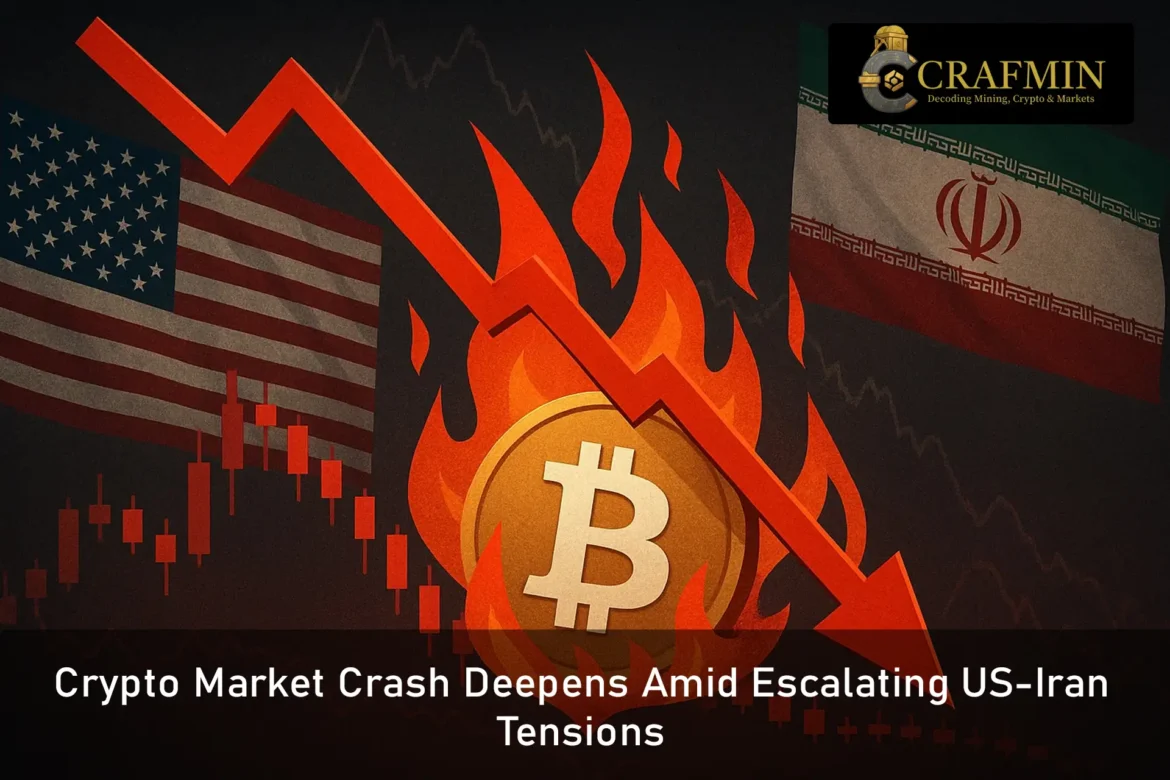The crypto world is reeling as geopolitical shockwaves send digital assets plummeting. A sudden missile strike by the United States on Iranian targets has sparked global uncertainty—and crypto markets are among the first to reflect the chaos. As tensions escalate between the US and Iran, investors are rapidly pulling out of high-risk assets, sparking a broad sell-off throughout the cryptocurrency market.

Retail traders panicked across chat groups ( Image Source: The Economic Times )
SPX, Virtual, WIF Among the Biggest Casualties
Leading the downturn are tokens SPX, Virtual, and WIF—each suffering significant price drops. SPX has tumbled over 12% in a matter of hours. Virtual isn’t far behind with a 14% plunge, while WIF, a meme-inspired token, slumped by 10%. Market sentiment turned sour almost instantly, with traders reacting to the geopolitical developments at lightning speed.
Unlike routine corrections driven by market mechanics or investor cycles, this crash is emotionally and politically charged—fuelled by fears of escalation and broader conflict.
Bitcoin Struggles to Stay Resilient
Bitcoin, often touted as a hedge against uncertainty, is finding it difficult to maintain its footing. Although it hovers near the $65,000 mark, bearish pressure is building fast. Ethereum is also feeling the impact, slipping toward $3,400. The so-called safe zones of the digital economy are being tested in real-time.
The underlying cause of this market disruption—armed conflict—highlights how vulnerable even decentralised finance is to real-world crises. As real-world conflict intensifies, cryptocurrencies are showing the same level of vulnerability as conventional financial assets.
A Global Sell-Off Driven by Fear
Beyond charts and technical analysis, crypto is about people—and people are panicking. As news broke of the strike, exchanges lit up with sell orders. Trading platforms saw a surge in activity, while social media channels exploded with panic, confusion, and concern.
Retail investors were hit the hardest in the initial wave. Countless long positions were swiftly wiped out, causing portfolios to shrink within minutes. Platforms like Telegram and Discord buzzed with anxious chatter and hasty strategy changes.
“This is heartbreaking,” posted one anonymous trader. “We had just started to gain momentum. Now it’s slipping away again.”
Also Read: Davis Commodities Bets Big on Bitcoin to Modernise Trade
The Real-World Impact on Decentralised Finance
Historically, war and political tension affected assets like oil, gold, and stocks. Now, crypto has officially joined that list. The decentralised promise of cryptocurrency doesn’t exempt it from global realities. If anything, the borderless nature of digital tokens makes them more susceptible to waves of fear that travel faster than any economic indicator.
Liquidity is draining as investors seek safe havens. Stablecoins like USDC and USDT are witnessing an uptick in volume as traders temporarily park their funds in less volatile instruments. Meanwhile, mainstream exchanges report increased movement, indicating massive portfolio readjustments in real-time.
Market-Wide Bloodbath Hits Altcoins
The impact isn’t isolated to a few tokens. Beyond SPX, Virtual, and WIF, a wide range of altcoins—particularly those in the meme, GameFi, and DeFi sectors—are seeing double-digit losses. Even projects with solid fundamentals are down, suggesting this isn’t about long-term viability but short-term emotional reaction.
The broader message is clear: when missiles fly, no crypto is truly safe.

Altcoins Plunge Across the Board ( Image Source: DailyCoin )
Experts Sound the Alarm
Market experts are voicing serious concerns. Without immediate diplomatic efforts, the market could spiral further.
“This is no longer just a crypto story,” says Sara Lim, a strategist at TerraVault. “What we’re seeing is a cross-market liquidity crisis. And speculative assets like crypto are the first to be impacted.”
Others highlight how algorithmic trading and auto-sell mechanisms are likely accelerating the downturn. As volatility increases, these systems often trigger cascading sell orders that deepen the losses.
What Traders Should Consider Now
For investors, this crash underscores a painful but vital lesson: global instability can undermine even the strongest technical patterns. Black swan events like armed conflict remain outside the reach of blockchain governance—but can severely shake its markets.
Newcomers should understand the importance of diversification and risk management. For seasoned traders, this is a stress test—both financially and psychologically.
Some view this moment as a buying opportunity, believing that the fear will subside. Others are staying on the sidelines, watching and waiting. But very few remain indifferent. Every move is calculated, every signal watched closely.
Looking Ahead: Relief or Deeper Pain?
The coming days are crucial. The crypto market hangs in a precarious balance. If diplomatic engagement prevails, there’s hope for a relief rally. However, if tensions escalate further, the downtrend could deepen—possibly triggering a prolonged bear cycle.
What’s evident is that crypto’s trajectory is now heavily tied to real-world events. Digital assets, once seen as immune to traditional politics, are clearly not spared in times of global conflict.
Final Thoughts
From high-cap tokens like Bitcoin to speculative coins like WIF and SPX, the current crash reveals just how interconnected crypto has become with global geopolitics. What was once a detached, decentralised space is now deeply reactive to the same headlines that move oil, gold, and stock indices.
Whether this crash marks a temporary setback or the start of a longer-term decline depends less on market fundamentals—and more on what happens next between governments. In the meantime, the message is clear: in the world of crypto, awareness and agility are as valuable as your wallet.

